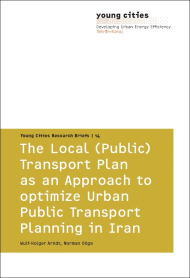The Local (Public) Transport Plan as an Approach to optimize Urban Public Transport Planning in Iran

Format: 14,8 x 21,0 cm
Publishing year: 2014
In many countries, the exclusive concentration on a simple extension of the road based transportation network led to growing individual car traffic hence to additional demand for roads and striking external effects of transport. All issues have a severe negative impact on the living and working conditions within many urban centers. In the last decade, especially in the MENA (Middle East and North Africa) region, municipalities tried to restrict continuous growth of car traffic and intensified their efforts in supporting alternative concepts with focus on environmentally-friendly mobility approaches. However, many of these approaches were quite ambitious and innovative but often rather implemented in a disintegrated way. The transport research activities that have been conducted during the project runtime of the Young Cities in Iran project within in the BMBF (German Federal Ministry of Research and Education) funded Megacities program investigated the urban transport sector of the MENA region in general and the one of Iran in detail. The researchers revealed that the Iranian urban public transport planning system is lacking coordination between the level of the Urban Transportation Masterplan and the level of public transport operators. This publication analyses the tool of the Local (Public) Transport Plan which is already used in many agglomerations worldwide to define fixed quality and service standards for urban public transport. It, moreover, investigates the Iranian urban transport planning system and suggests a way how to adapt the tool to fit with Iranian conditions.


